06 July 2023
Summer sun brings RESPONSUM’s delight,
A sizzling upgrade, shining so bright. ☀️
Get ready to explore a treasure trove of new features and enhancements in version 1.19.0! In this article, we’ll take you through some of the most impactful additions that are sure to make your RESPONSUM experience even better. So let’s jump right in and discover what’s in store for you in this exciting release! 🚀
General
In general, we have made several improvements to enhance the overall performance of RESPONSUM. One particular area of focus has been the Register sub-module.
In terms of user experience, we have implemented a feature in the sub-module overview. Now, when you navigate away from the page and return later, RESPONSUM will remember your filters and the page number you were on. This ensures a smoother and more seamless workflow.
We also worked on the login process. If you attempt to log in to RESPONSUM using your Microsoft or Google account, but you don’t have a pre-existing RESPONSUM account, you will now receive a clear message explaining why you are unable to log in. This provides better clarity and avoids any confusion.

To offer more customization options, we have introduced new filters for notifications. These filters allow you to personalize your notification settings according to your preferences, ensuring that you receive relevant information.
Register
Furthermore, we have introduced significant improvements to various tabs in our system. Let’s take a closer look at the changes:
First off, we have completely redesigned the Retention Period tab to offer enhanced configuration capabilities. You can now set multiple retention periods for specific data subject types and attributes. This means you have the flexibility to define different timeframes for retaining different types of data, providing more precise control over data retention.
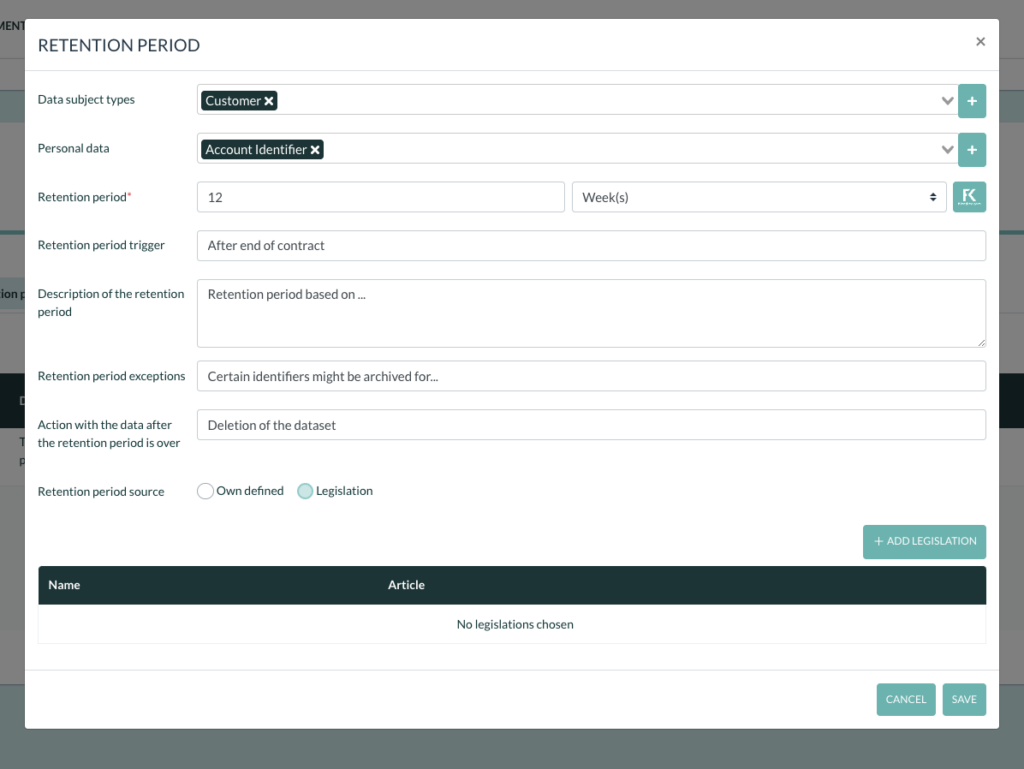
Secondly, the Personal Data tab has undergone updates to include new flags: “Captured directly from the data subject?” and “External source?” These flags can be set independently, allowing you to indicate whether the data was obtained directly from the data subject or from an external source. Additionally, we have introduced the option to link both internal and external data sources simultaneously. This enhancement enables you to have a comprehensive view of data origins and sources, facilitating better data management.
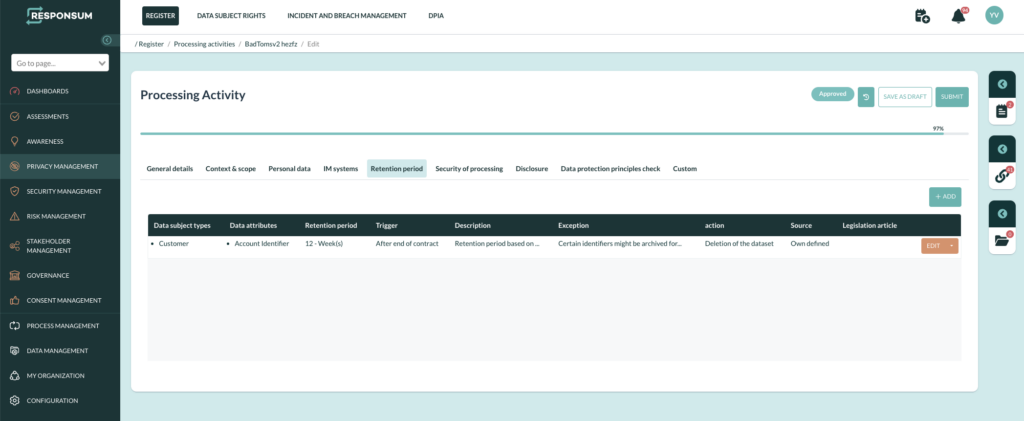
What’s more: Previously, you were limited to selecting only one legal ground for a processing activity. However, based on user feedback and regulatory requirements, we have enhanced the system to allow the selection of multiple legal grounds. This update ensures that you can accurately reflect the various legal justifications applicable to a specific processing activity, promoting compliance and transparency.
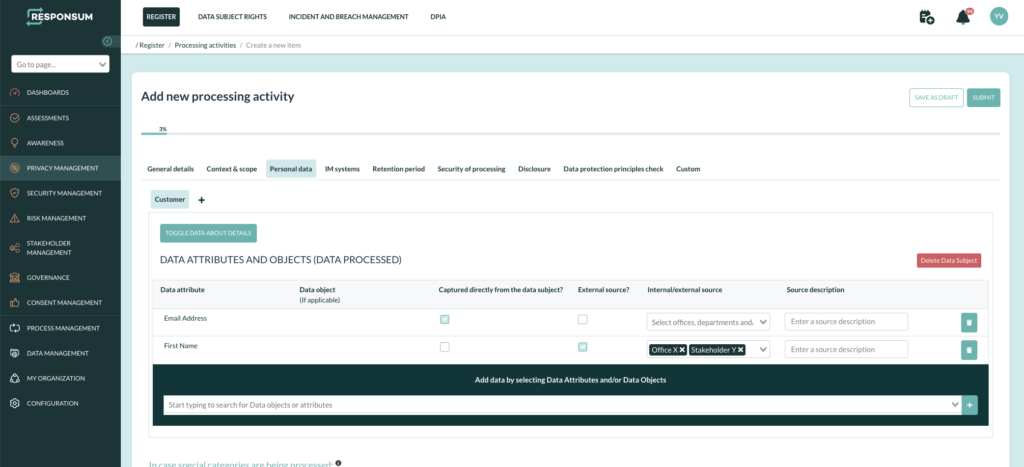
In addition to the previous point, we have also introduced the ability to set multiple legal bases for a processing activity. This feature empowers you to specify multiple legal bases, such as consent, contractual necessity, legitimate interest, etc. for a single processing activity. By offering this capability, we enable a more comprehensive and nuanced representation of the legal framework supporting your processing activities.
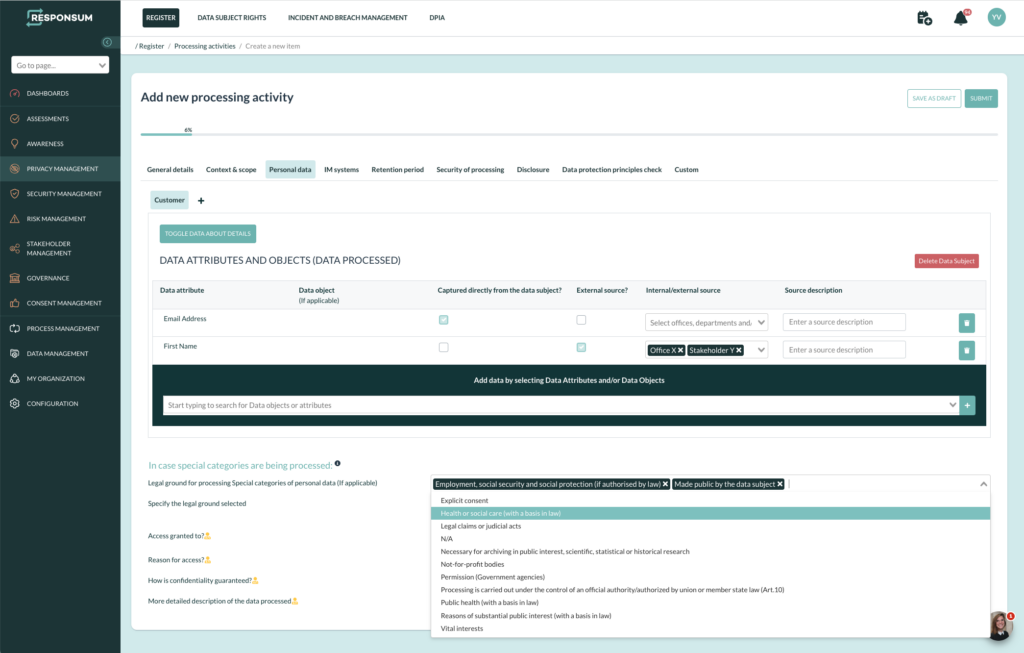
These updates provide greater flexibility, accuracy, and compliance within the system, allowing you to effectively configure retention periods, track data sources, and ensure adherence to legal requirements.
Risk Management
We have implemented several updates to enhance the risk management capabilities in RESPONSUM. These improvements aim to streamline the process of managing and tracking risks within the system.
For starters, you can now archive risks within the risk register and risk dictionary. This feature allows you to securely store and maintain a record of past risks, providing a comprehensive historical overview of your organization’s risk landscape.
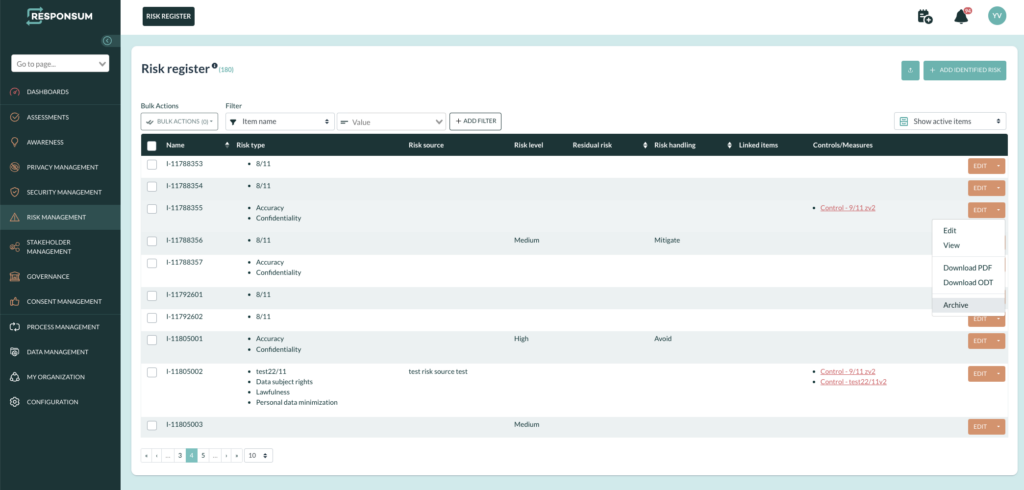

Secondly, a new functionality has been added that enables you to assign a residual risk probability and risk impact to each identified risk. By assigning these values, you can assess the remaining level of risk after implementing mitigation measures. The system automatically calculates the residual risk level based on your risk strategy and the assigned residual probability and impact, providing valuable insights for risk analysis and decision-making.
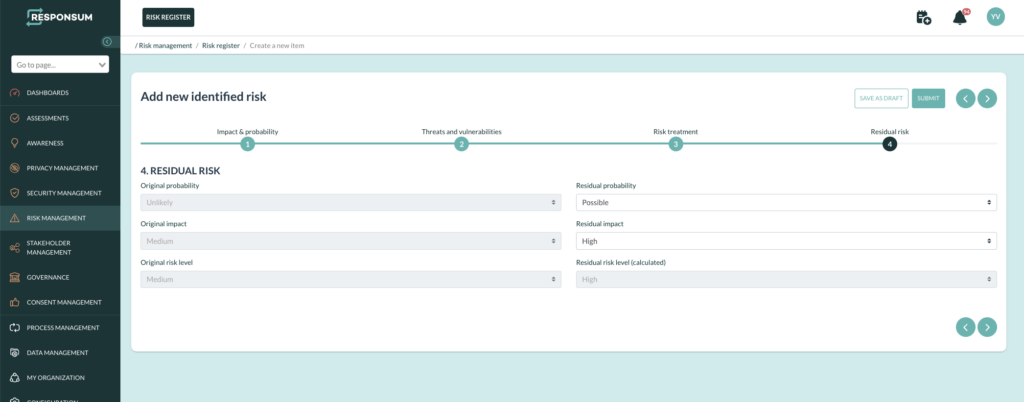
Additionally, in the risk management table, the controls and measures associated with a specific risk are now clickable. This improvement allows you to conveniently navigate directly to the corresponding control or measure, saving time and effort in accessing and managing risk-related actions.
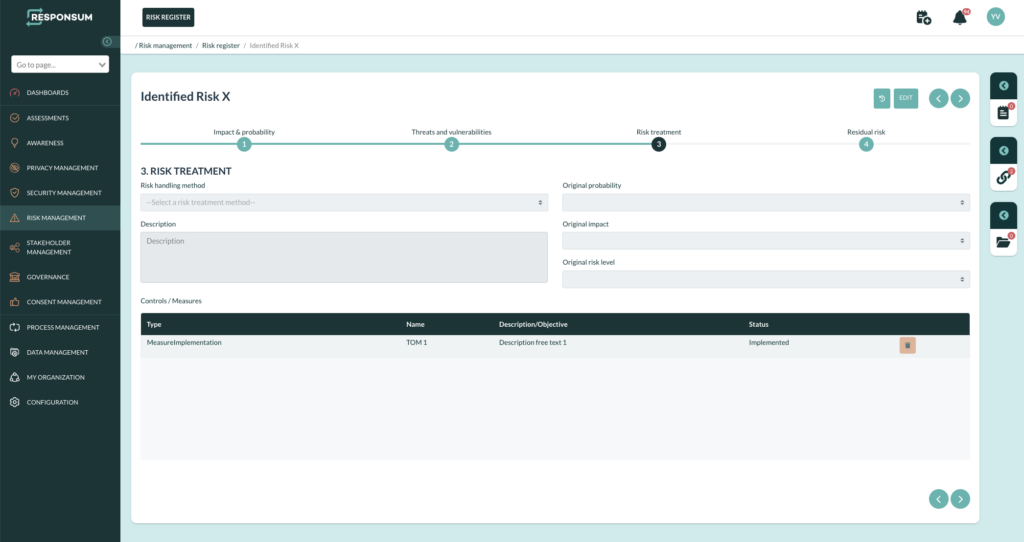
What’s more: Offices and departments can now be assigned to individual risks within the risk register. This feature enables you to associate risks with the relevant organizational units, facilitating better risk ownership and accountability. It provides a clearer understanding of which departments or offices are responsible for managing specific risks.
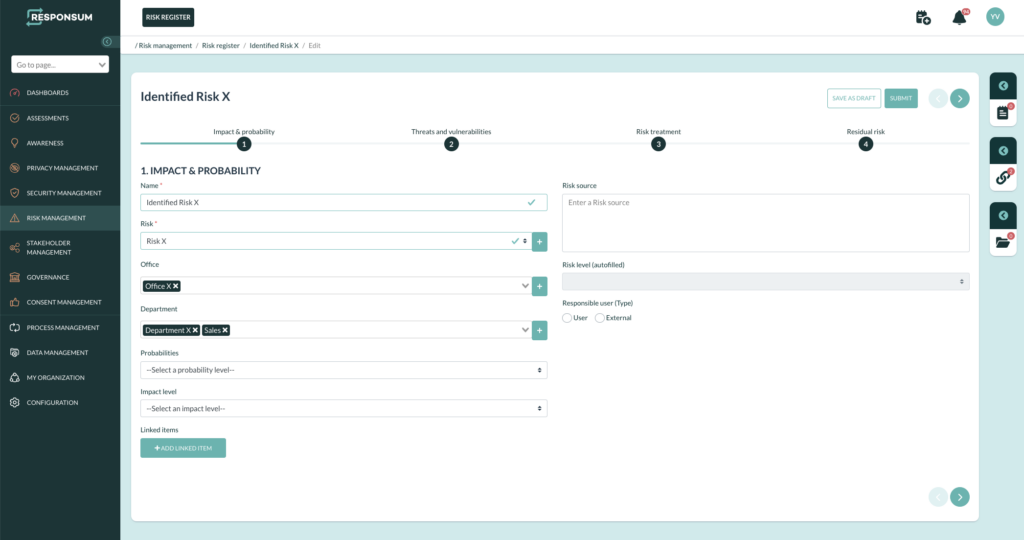
Furthermore, the risk register and dictionary now feature enhanced importers, simplifying the process of importing your existing risk register into RESPONSUM. This enhancement streamlines the transition of your current risk management data into the system, ensuring a smooth and efficient migration process.
These updates enhance the overall risk management functionality of RESPONSUM, allowing you to archive risks, assess residual risk levels, navigate to relevant controls and measures, assign offices and departments, and facilitate the importation of your current risk register. These features contribute to a more streamlined and comprehensive risk management process within the system.
Data Management
We have introduced a new feature that enhances data classification in RESPONSUM. With this update, you can now add data objects to the Data Classification levels set within the system.By doing so, you can effectively categorize and organize your data based on its sensitivity, importance, or any other relevant criteria.
By leveraging this functionality, you can enhance data governance, compliance, and security within your organization. It facilitates better control and management of data assets, enabling you to make informed decisions regarding data handling, access controls, and risk mitigation strategies.
My Organization
We have made significant updates to improve the functionality and accessibility of the “Actors” feature within RESPONSUM. To provide a clearer representation of its purpose, we have rebranded it as “Functions.” This name change better reflects the role and purpose of this feature.
Furthermore, we have ensured that the “Functions” feature is more readily available throughout various sub-modules in the system. This means that you can easily access and utilize this functionality wherever it is relevant within RESPONSUM.
Additionally, you can now assign a function directly to a user. This enhancement allows you to associate specific functions with the appropriate individuals, streamlining user management and ensuring that the right users have access to the relevant functions within the system.
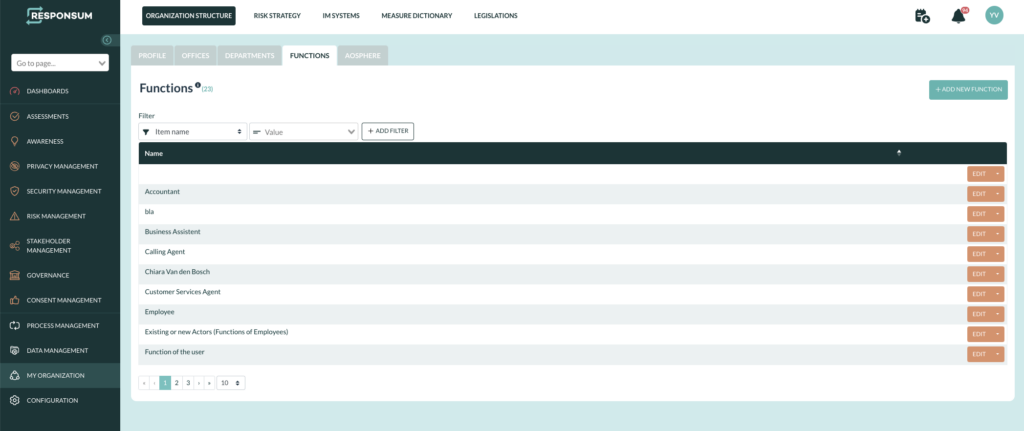
IM Systems
We have implemented several updates to enhance the management of Information Management (IM) systems in RESPONSUM. These improvements aim to provide more flexibility, accuracy, and efficiency in handling IM systems.
First off, we have added a new multi-select owner field, allowing you to assign one or more IM system owners. This feature provides more flexibility in assigning ownership responsibilities and ensures that the appropriate individuals or departments are associated with the IM systems.
What’s more: Previously, only the location of operation could be set for IM systems. However, we have expanded the options by introducing the ability to designate offices and departments as the “Owners” or “Managers” of IM systems. This enhancement allows for a more accurate representation of the responsible entities within the organization. You can now associate specific offices or departments with the ownership or management of IM systems, improving transparency and accountability. Furthermore, we have introduced a feature that allows you to define an interval for reviewing IM systems. This functionality enables you to set a specific timeframe for reviewing and updating the details of each IM system. By defining the review interval, you can establish a schedule for regular system assessments and ensure that necessary updates and modifications are addressed in a timely manner. The system will provide timed notifications to remind you of the review dates, helping to maintain the accuracy and relevancy of IM system details.
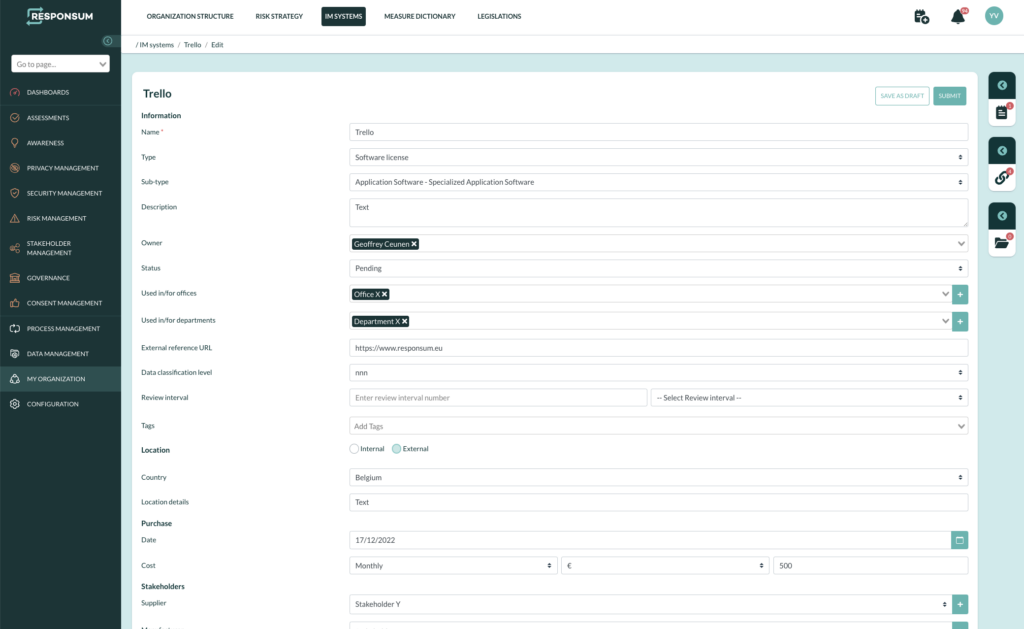
User Management
We have implemented an update to the Active Directory sync feature in RESPONSUM. With this update, you can now create new users through the AD sync as “SSO-only” users. These users can exclusively log in to RESPONSUM using Microsoft or Google identity providers.
This enhancement provides more flexibility in user management and authentication options. By allowing the creation of SSO-only users through the AD sync, you can streamline the login process for those who prefer using Microsoft or Google credentials. It simplifies user access while maintaining security and authentication standards.
We believe that these updates will greatly enhance your experience with RESPONSUM. If you have any questions or encounter any issues, please feel free to reach out to our dedicated support team. They are available to assist you and ensure a smooth and productive experience with the system.
